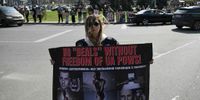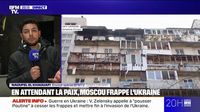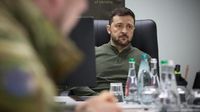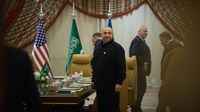In a significant development in the ongoing war between Ukraine and Russia, discussions between Ukrainian and American officials began on March 23, 2025, in Riyadh, Saudi Arabia, amid heightened tensions and recent escalations in violence. These talks aimed to explore possibilities for a partial truce, particularly focusing on attacks against energy infrastructure.
Ukrainian Defense Minister Rustem Umerov, who heads the delegation from Kyiv, announced that the discussions were productive and centered on critical proposals designed to protect energy facilities. Umerov stated, “We concluded our meeting with the American team. The discussion was productive and focused. We addressed key issues, including energy.” As the war rages on since February 2022, the humanitarian impact has grown dire, with the urgency for peace intensifying.
However, the backdrop of these discussions could not be more turbulent. On the night leading up to the talks, Russian drone strikes on Kyiv resulted in at least three fatalities, including a five-year-old child, and left ten others injured. The bombings, described as “massive” by Kyiv's Mayor Vitali Klitschko, inflicted damages across several districts of the capital and highlighted the ongoing danger faced by civilians.
Ukrainian President Volodymyr Zelensky reacted to these tragic events, calling for greater international pressure on Russian President Vladimir Putin to cease such hostilities. “We must push Putin to give a real order to stop the strikes: the one who started the war must finish it,” he declared in a statement on social media, underscoring the dire need for an effective resolution.
The upcoming negotiations marked a critical juncture, with President Zelensky also advocating for a complete and unconditional ceasefire. Yet, the Kremlin projected a more cautious tone, anticipating “difficult negotiations” ahead. Kremlin spokesperson Dmitri Peskov noted, “It is a very complex subject, and there is a lot of work to do,” emphasizing the challenges that lay ahead as negotiators seek to find common ground.
Meanwhile, the recent Russian military activity cannot be overlooked, as Russian forces declared on March 23 that they had seized the eastern locality of Sribné, further complicating the military landscape. The Ukrainian army, conversely, reported a rare success in reclaiming the village of Nadia in the Luhansk region, recovering three square kilometers of territory after an intensive thirty-hour operation.
In a related discussion, U.S. special envoy Steve Witkoff expressed optimism regarding the ongoing negotiations, telling Fox News, “I think you’re going to see real progress in Saudi Arabia on Monday, particularly regarding the Black Sea – a cease-fire on the ships between both countries, and from there, we’ll naturally move toward a total cease-fire of hostilities.” Witkoff's statements provided a glimmer of hope amidst the ongoing turmoil.
The backdrop of these negotiations is compounded by concerns over the state of international diplomacy and the need for tangible outcomes. The Biden administration appears to be pushing for not only a ceasefire but a strategy that will enable discussions around the long-term resolution of the conflict, including energy concerns pivotal to both nations and their populations.
As the situation unfolds, the international community watches closely. Zelensky’s call for allies to exert pressure on Russia rings particularly urgent following the wave of drone attacks that profoundly affected Kyiv and its citizens' morale.
The stakes are undeniably high as the two sides gear up for a new round of negotiations set for March 24, 2025, where U.S. and Russian delegations will also meet. The outcome of these discussions may determine future strategies and the potential for a ceasefire that many in Ukraine and the surrounding regions desperately hope for.
In conclusion, the details of the discussions in Riyadh reflect the fragile nature of the situation, where each day brings new challenges and casualties. The commitment from both sides to engage in dialogue will be tested in the coming days as the world observes their efforts to navigate the path toward peace amidst relentless violence.









